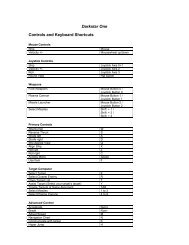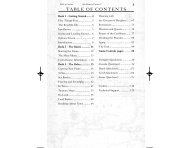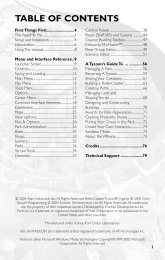Heads-Up Display Modes 35 - Metaboli
Heads-Up Display Modes 35 - Metaboli
Heads-Up Display Modes 35 - Metaboli
You also want an ePaper? Increase the reach of your titles
YUMPU automatically turns print PDFs into web optimized ePapers that Google loves.
80 Radar Warning Receivers<br />
processing power, the RWS not only detects radar, but also indicates the bearing<br />
to the transmitter and the type of radar detected. A totally passive system, it<br />
merely listens for other’s emissions. This system is used in a variety of Russian<br />
aircraft including the MiG-29 Fulcrum , MiG-31 Foxhound, and Mi24P Hind.<br />
The ten lights surrounding the MiG-21 picture illuminate to indicate the bearing to<br />
the transmitter. A flashing light indicates your aircraft is being painted occasionally<br />
by the emitter. A solid light indicates that a transmitter is tracking your aircraft. A<br />
red light surrounding the silhouette indicates a lock onto your aircraft. The six lights<br />
along the bottom of the RWS correspond, from left to right, to five categories of<br />
radar signals:<br />
• Airborne radar<br />
• Short-ranged SAM<br />
• Medium-ranged SAM<br />
• Long-ranged SAM<br />
• Early warning radar<br />
• AWACS<br />
Threat Bearing<br />
Indicators<br />
Lock-On Detected<br />
Radar Type<br />
Indicators<br />
All Russian aircraft are equipped with an Identification Friend or Foe (IFF) system,<br />
allowing the RWS to distinguish between friendly and hostile radar sources. This<br />
system also replies to friendly emitters, alerting them that you’re not a hostile<br />
target.<br />
Missile Launch Warning System<br />
The infrared MLWS detects the hot emissions produced by incoming missiles. A<br />
totally passive system, it watches for the type of heat produced by solid-propellant<br />
rocket motors. Its effective range varies depending on the intensity of the heat<br />
emission, but can generally spot inbound missiles up to 15 km away.<br />
When the MLWS detects an inbound missile, the GECR symbol (meaning<br />
“launch” in Russian) illuminates and produces a warning beep at 2 Hz for five<br />
seconds. The MLS light also illuminates. After five seconds the audio alarm<br />
silences, but the warning light remains on until the system loses contact with the<br />
missile.















